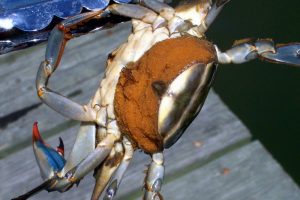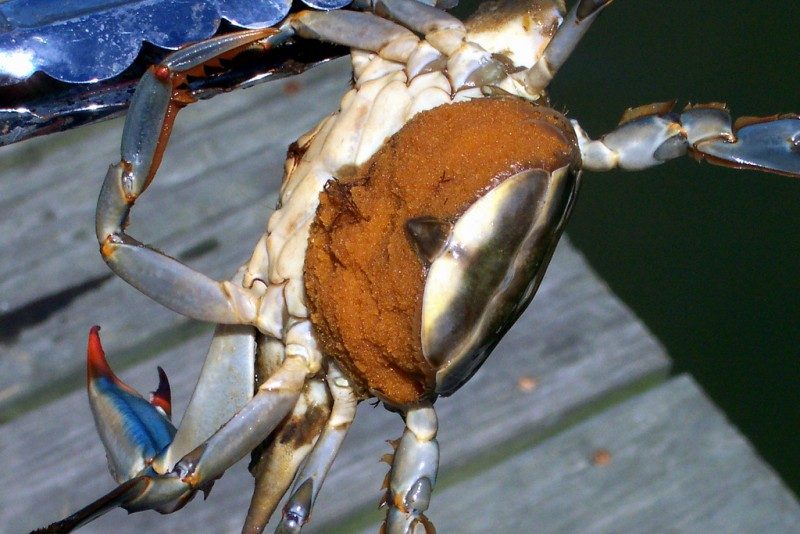
Female blue crabs develop an egg-bearing mass, called a ‘sponge,’ beneath their apron after mating. Each sponge can contain hundreds of thousands to millions of eggs. (David Saddler/ Flicker. Photo Courtesy Chesapeake Bay Program)
Responding to pleas from Maryland crab processors suffering from a depressed harvest this year, a state advisory group is proposing to relax a regulation that could allow importing nearly twice as many egg-bearing female crabs for crabmeat.
But some Maryland crabbers object, warning that the move would undercut their income and endanger the future of the entire Chesapeake Bay fishery.
By a vote of 12 to 2, with two abstentions, the Department of Natural Resources’ Blue Crab Industry Advisory Committee voted last month to nearly double the time period each year when state seafood businesses would be permitted to import “sponge crabs,” pregnant females carrying an egg sac on the outside of their bodies.
Sponge crabs have long been illegal to harvest in Maryland. But they’re legal to harvest in Virginia, though that state does bar taking “dark” sponge crabs about to release their eggs.
After mating, female crabs migrate down the Chesapeake into Virginia to spawn, or release their fertilized eggs. The crabs form a sack, or sponge, outside their bodies. They produce hundreds of thousands to millions of eggs, but only a fraction of them make it to adulthood. During this stage, they have less meat because they are putting their energy into reproduction, and therefore are not desirable for the live crab market. But they are bought by crabmeat processors or picking houses in Virginia and Maryland.
In 2002, former Gov. Parris N. Glendening banned the import of sponge crabs into Maryland. But his successor, Robert Ehrlich Jr., opened a window for the struggling processors the next year. Under current regulations, processors can import sponge crabs from April 25 to July 5.
The DNR’s crab industry advisory panel called for increasing the import window to 122 days, from April 15 to August 15. The recommendation now goes to the department’s Tidal Fisheries Advisory Commission, which will take it up in late October. If the move gains that group’s approval, DNR officials said they would formally propose the change and seek public comment, with the intent to make it effective by next season, which begins April 1.
Two Dorchester County crab processors on the industry advisory committee, Jack Brooks of J.M. Clayton Co. in Cambridge and Aubrey Vincent, of Lindy’s Seafood Inc. in Woolford, have been pushing for this change for some time.
Processors want the change
Like many processors, Brooks and Vincent’s company rely on seasonal crabmeat pickers who come from Mexico on H2-B visas. Each hires about 100 immigrant workers annually. The processors say they must request visas before they know how the year’s crab harvest is likely to go, and are required to pay the workers, whether there are crabs to pick or not.
This year was particularly brutal, the processors said; the crab harvest fell off dramatically after July 4, according to crabbers, as the winter dredge survey had predicted it would. Surveyors counted a low number of juveniles, meaning there would be fewer crabs than in previous years maturing to legally harvestable size in late summer and fall.
Other states allow harvests and imports of sponge crabs, without restrictions, according to DNR officials, though since 1996, Virginia has restricted harvest on “dark” sponge crabs. As a result, Vincent said, Maryland processors suffer economic losses that their competitors in other states don’t have to bear.
“There were plants (in Maryland) that didn’t pick one day a week, and all those other states picked those crabs while we all sat and watched them do it,” Vincent said.
Brooks, who has been pushing for years for more imports, initially asked for a complete lifting of restrictions on sponge imports. Facing resistance from crabbers who worried about sponges undercutting the prices they could get for their harvest, Brooks assured them he would only buy sponge crabs when their catch wasn’t available.
“My quality is better when I pick from the dock,” Brooks said. “We go to sponge crabs when there are not enough local crabs. The processors in North Carolina and Louisiana are taking those sponge crabs. They’re going to get pulled out of the water anyway in the jurisdictions where they are legal.”
Male hard crabs fetch about $110 a bushel dockside right now; females are closer to $40, and female sponge crabs are about $5 less per bushel, according to some crabbers. Brooks and Vincent insisted that importing more sponge crabs wouldn’t hurt other crabbers’ prices or the overall Bay crab population.
Crabbers remain concerned
But some crabbers remained concerned, suggesting that the industry seemed to be cutting its own throat, especially coming off a dismal season. Willy Dean, a Southern Maryland crabber, said the fishery would not survive if Maryland created a market for Virginia to take out more egg-bearing females.
“If we open this wide, in three years, you can take your crab pots and trot lines and burn them up,” said Dean, one of only two crabbers to vote against the provision. The other, Tommy Zinn, is also from Southern Maryland.
Billy Rice, another Southern Maryland waterman, abstained from voting because he chairs the Tidal Fisheries Advisory Commission. Nevertheless, he expressed dismay at the proposed change. A sponge, he said, is worth 25 cents and produces thousands of offspring.
“Do you think a 25-cent crab is worth picking when it can produce that?” he asked. “This is where our next crop of crabs is coming from.”
If the public knew crabmeat came from an egg-bearing female, Rice added, it would sit on the shelf and rot.
Reached by phone Friday as he was crabbing, Rice said it wasn’t fair to make hard-working watermen sacrifice their future because processors had a labor issue. He predicted that Virginia watermen would harvest more sponge crabs, saying that Maryland is their main market.
Sacrificing the fishery
‘There’s no doubt that the picking industry is needed, but can we sacrifice the whole fishery?” he asked. “There’s a shortage of crabs, but how can we justify filling that hole when what we fill it with are crabs that are ready to spawn and rejuvenate the population?”
Rice said he wonders if the lack of harvest restrictions in the 1990s helped bring on the crab crisis then, when both Maryland and Virginia imposed limits.
DNR officials said they didn’t know how many crabs state processors import in a given year. And Virginia doesn’t make a distinction in its harvest reports on whether a female crab has a sponge or not. The number of crab houses has dropped from 49 in 1997 to about 20 today.
Mike Luisi, director of monitoring and assessment with the DNR’s fishing and boating services, said the department doesn’t believe the sponge crab import is a resource-management issue. Rather, it’s an economic one.
“We don’t see it as an issue for managing crabs,” Luisi said. “A mature female that we harvest now, it will be a sponge crab later. It’s a pregnant female, you either take it at one month or nine.”
Luisi, who spent much of his career handling striped bass, has been working on crabs since February, when the Hogan Administration fired its longtime crab fishery manager, Brenda Davis. Davis was dismissed after Dorchester County watermen complained to the governor that the DNR would not relax its harvest rules so they could take smaller male crabs, which also were bound for picking houses. Davis’ position hasn’t been filled yet.
By Rona Kobell
Bay Journal
Bay Journal is published by Bay Journal Media, a 501(c)(3) nonprofit, to inform the public about issues that affect the Chesapeake Bay. A print edition is published monthly and is distributed free of charge. News, features and commentary are available free online at bayjournal.com. MarylandReporter.com is partnering with the Bay Journal by publishing one of its articles every Friday.

Female blue crabs develop an egg-bearing mass, called a ‘sponge,’ beneath their apron after mating. Each sponge can contain hundreds of thousands to millions of eggs. (David Saddler/ Flicker. Photo Courtesy Chesapeake Bay Program


